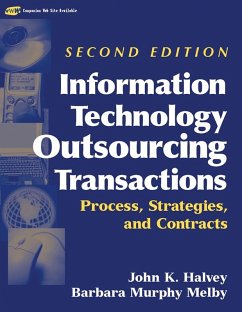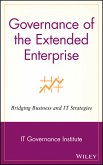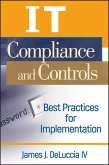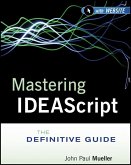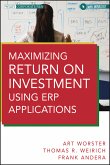John K. Halvey, Barbara Murphy Melby
Information Technology Outsourcing Transactions (eBook, PDF)
Process, Strategies, and Contracts
188,99 €
188,99 €
inkl. MwSt.
Sofort per Download lieferbar

0 °P sammeln
188,99 €
Als Download kaufen

188,99 €
inkl. MwSt.
Sofort per Download lieferbar

0 °P sammeln
Jetzt verschenken
Alle Infos zum eBook verschenken
188,99 €
inkl. MwSt.
Sofort per Download lieferbar
Alle Infos zum eBook verschenken

0 °P sammeln
John K. Halvey, Barbara Murphy Melby
Information Technology Outsourcing Transactions (eBook, PDF)
Process, Strategies, and Contracts
- Format: PDF
- Merkliste
- Auf die Merkliste
- Bewerten Bewerten
- Teilen
- Produkt teilen
- Produkterinnerung
- Produkterinnerung

Bitte loggen Sie sich zunächst in Ihr Kundenkonto ein oder registrieren Sie sich bei
bücher.de, um das eBook-Abo tolino select nutzen zu können.
Hier können Sie sich einloggen
Hier können Sie sich einloggen
Sie sind bereits eingeloggt. Klicken Sie auf 2. tolino select Abo, um fortzufahren.

Bitte loggen Sie sich zunächst in Ihr Kundenkonto ein oder registrieren Sie sich bei bücher.de, um das eBook-Abo tolino select nutzen zu können.
A completely revised update of the First Edition, this book focuses exclusively on outsourcing information technology such as data processing, computer systems, and specialized software programs essentially an intellectual property transaction. It covers, among other topics, licensing and software development agreements, sales of tangible assets, human resources management, and more.
- Geräte: PC
- mit Kopierschutz
- eBook Hilfe
- Größe: 14.58MB
Andere Kunden interessierten sich auch für
![Governance of the Extended Enterprise (eBook, PDF) Governance of the Extended Enterprise (eBook, PDF)]() It Governance InstituteGovernance of the Extended Enterprise (eBook, PDF)96,99 €
It Governance InstituteGovernance of the Extended Enterprise (eBook, PDF)96,99 €![The E-Business Workplace (eBook, PDF) The E-Business Workplace (eBook, PDF)]() Pricewaterhousecoopers LlpThe E-Business Workplace (eBook, PDF)37,99 €
Pricewaterhousecoopers LlpThe E-Business Workplace (eBook, PDF)37,99 €![IT Compliance and Controls (eBook, PDF) IT Compliance and Controls (eBook, PDF)]() James J. DeLucciaIT Compliance and Controls (eBook, PDF)50,99 €
James J. DeLucciaIT Compliance and Controls (eBook, PDF)50,99 €![Mastering IDEAScript (eBook, PDF) Mastering IDEAScript (eBook, PDF)]() IdeaMastering IDEAScript (eBook, PDF)169,99 €
IdeaMastering IDEAScript (eBook, PDF)169,99 €![Maximizing Return on Investment Using ERP Applications (eBook, PDF) Maximizing Return on Investment Using ERP Applications (eBook, PDF)]() Arthur J. WorsterMaximizing Return on Investment Using ERP Applications (eBook, PDF)60,99 €
Arthur J. WorsterMaximizing Return on Investment Using ERP Applications (eBook, PDF)60,99 €![Fraud and Fraud Detection (eBook, PDF) Fraud and Fraud Detection (eBook, PDF)]() Sunder GeeFraud and Fraud Detection (eBook, PDF)52,99 €
Sunder GeeFraud and Fraud Detection (eBook, PDF)52,99 €![Artificial Intelligence for Audit, Forensic Accounting, and Valuation (eBook, PDF) Artificial Intelligence for Audit, Forensic Accounting, and Valuation (eBook, PDF)]() Al NaqviArtificial Intelligence for Audit, Forensic Accounting, and Valuation (eBook, PDF)32,99 €
Al NaqviArtificial Intelligence for Audit, Forensic Accounting, and Valuation (eBook, PDF)32,99 €-
-
-
A completely revised update of the First Edition, this book focuses exclusively on outsourcing information technology such as data processing, computer systems, and specialized software programs essentially an intellectual property transaction. It covers, among other topics, licensing and software development agreements, sales of tangible assets, human resources management, and more.
Dieser Download kann aus rechtlichen Gründen nur mit Rechnungsadresse in A, B, BG, CY, CZ, D, DK, EW, E, FIN, F, GR, HR, H, IRL, I, LT, L, LR, M, NL, PL, P, R, S, SLO, SK ausgeliefert werden.
Produktdetails
- Produktdetails
- Verlag: John Wiley & Sons
- Seitenzahl: 648
- Erscheinungstermin: 27. Oktober 2005
- Englisch
- ISBN-13: 9780471746171
- Artikelnr.: 38205140
- Verlag: John Wiley & Sons
- Seitenzahl: 648
- Erscheinungstermin: 27. Oktober 2005
- Englisch
- ISBN-13: 9780471746171
- Artikelnr.: 38205140
- Herstellerkennzeichnung Die Herstellerinformationen sind derzeit nicht verfügbar.
John K. Halvey is a partner in the New York office of the international law firm of Milbank, Tweed, Hadley & McCloy, LLP and the founder of the Technology & Strategic Sourcing Group. He practices in all areas of technology and sourcing law, with particular emphasis on information technology and business process outsourcing and private equity transactions involving technology or sourcing companies. Mr. Halvey has represented companies in many of the largest technology, telecommunications, and business process outsourcing transactions, including Deutsche Bank, BellSouth, Panasonic, DuPont, AT&T, Alcatel, Xerox, Boeing, Bombardier, General Atlantic, and the Commonwealth Bank of Australia. His work in these areas has been the subject of articles in Forbes, Information Week, ComputerWorld, CIO Magazine, The Daily Deal, and Venture Capital Journal. Mr. Halvey has for many years been ranked by Chambers and Partners as one of the world's leading IT and outsourcing lawyers and in 2005 was the only lawyer in the United States to be ranked a "Star Performer" in the outsourcing industry. In 1995, Crain's named Mr. Halvey on its list of the 40 most successful people under 40 in New York City. He is also listed in The Best Lawyers in America. He has published three other books: Business Process Outsourcing Transactions: Process, Strategies and Contracts; Data Processing Contracts, and Computer Law and Related Transactions. Mr. Halvey is a magna cum laude graduate of Tufts University, Emory University School of Business, and Emory University School of Law, where he was an executive editor of the Law Review. Barbara M. Melby is a partner in the Global Outsourcing Group. Ms. Melby's practice focuses primarily on outsourcing transactions, including information technology and business process outsourcing, as well as other technology-related transactions, including development agreements, system implementation agreements, licensing and hosting agreements, technology services, joint ventures, and strategic alliances. Ms. Melby represents a large and diverse client base and has led or participated in nearly 100 major outsourcing transactions. Most recently she has completed a large offshore outsourcing transaction for a major insurance company, a global IT outsourcing (ITO) transaction for a leading international media company, a multi-tower outsourcing transaction for a major global pharmaceutical company, and a human resources outsourcing (HRO) transaction for large services provider. In addition to this book, Ms. Melby has co-authored Business Process Outsourcing: Process, Strategies, and Contracts (John Wiley& Sons, 2000). She also has written numerous articles in and has been widely quoted in a wide variety of publications to include CIO Magazine, ITWorld, The Metropolitan Corporate Counsel, and The Pennsylvania Lawyer. Ms. Melby is also a frequent speaker on outsourcing and technology transactions at various business, legal, and professional conferences. She is a graduate of Vassar College and received her law degree from Boston University, magna cum laude. While at Boston University, she served as an editor on the Boston University Law Review and was a Distinguished Scholar.
About the Authors.
About the Web Site.
Preface.
Chapter 1: Overview of the IT Outsourcing Industry.
1.1 Background.
1.2 IT Outsourcing Industry.
1.3 IT Outsourcing Deals.
Chapter 2: Considering Outsourcing: The Request for Proposal and Vendor
Selection.
2.1 The Directive.
2.2 Obtaining Support and Forming the Outsourcing Team.
2.3 Guidelines and Internal Evaluation.
2.4 Preparing a Timetable.
2.5 Internal Communications.
2.6 Defining the Scope of the Transaction.
2.7 Selecting a Group of Potential Vendors.
2.8 Request for Proposal.
2.9 Evaluating the Proposals.
2.10 Notifying the Preferred Vendor(s).
Chapter 3: Negotiations: Strategy and Process.
3.1 Introduction.
3.2 Negotiating Process.
3.3 Exposure Analysis.
3.4 People Negotiate, Not Companies.
3.5 Negotiating Strategy.
Chapter 4: Outsourcing Contract.
4.1 Overview.
4.2 Use of Attorneys.
4.3 Key Contract Issues.
4.4 Retaining Strategic Control.
4.5 Assembling the Team.
Chapter 5: Exhibits.
5.1 Critical Part of the Outsourcing Contract.
5.2 Exhibit Listings.
5.3 Checklists.
Chapter 6: Financial Considerations.
6.1 Introduction.
6.2 Base Case.
6.3 Retained Costs.
6.4 Unit vs. Total Cost.
6.5 Pricing Options.
6.6 Other Financial Charges.
6.7 Financial Impact of Change.
6.8 Payments.
6.9 Chargeback.
Chapter 7: Human Resources.
7.1 Transitioning Employees to the Vendor.
7.2 Due Diligence.
7.3 The Employment Offer.
7.4 Communication and Transition Plan.
7.5 Contract-Related Issues.
7.6 Stay Incentives.
Chapter 8: Information Privacy and Security Issues.
8.1 Introduction.
8.2 Selected Information Privacy Laws.
8.3 Selected Information Security Laws.
8.4 Company Privacy Policies.
8.5 Outsourcing and Global Companies.
8.6 Offshore Outsourcing.
8.7 Practice Tips.
Chapter 9: Measuring Performance.
9.1 Overview.
9.2 Service Levels.
9.3 Benchmarking.
9.4 Customer Satisfaction.
9.5 Gainsharing.
Chapter 10: Transformational Outsourcing.
10.1 Moving from A to C.
10.2 Internal Considerations.
10.3 Project Definition.
10.4 Maintaining Multiple Environments.
10.5 Using Subcontractors.
10.6 Contract Terms.
Chapter 11: Global Transactions.
11.1 Overview.
11.2 Contract and Legal Issues.
Chapter 12: Business Process Outsourcing.
12.1 The Emerging Market.
12.2 What Is BPO?
12.3 Areas Targeted for BPO.
12.4 Reasons for Outsourcing Business Processes.
12.5 Integration: Making BPO Fit.
12.6 BPO Vendors.
Chapter 13: Internet-Enabled Outsourcing: The Virtual Frontier.
13.1 Introduction.
13.2 Potential Problems and Issues.
Chapter 14: Post-Negotiation Activities.
14.1 Contract Signing.
14.2 The Press Release.
14.3 The Autopsy.
14.4 Risk Analysis.
14.5 Contract Administration.
14.6 Implementing the Transition Plan.
14.7 Notifying Third Parties.
Chapter 15: Renegotiation and Termination.
15.1 Overview.
15.2 Renegotiation/Termination Process.
15.3 What Does the Contract Say?
15.4 Additional Issues to Consider.
15.5 Termination Plan.
Appendices.
Appendix 1.1 Outsourcing in the Pharmaceutical Industry.
Appendix 2.1 Nondisclosure Agreement (Mutual Protection).
Appendix 2.2 Request for Information.
Appendix 2.3 Request for Proposal.
Appendix 2.4 Customer Reference Questions: Sample.
Appendix 2.5 Vendor Proposals Relating to the Provision of Information
Technology Services Evaluation.
Appendix 2.6 Assessing Legal Resources Required (Customer Form):
Questionnaire.
Appendix 2.7 Due Diligence Agreement.
Appendix 2.8 Letter of Intent (Customer Form).
Appendix 2.9 Letter of Intent (Vendor Form).
Appendix 2.10 Consent Letter (Management of Third-Party Products/Services).
Appendix 3.1 Model Term Sheet.
Appendix 4.1 Key Issues in Outsourcing Agreements.
Appendix 4.2 Key Issues in Offshore Outsourcing Agreements.
Appendix 4.3 Key Issues in a Data Center Outsourcing Transaction.
Appendix 4.4 Information Technology Outsourcing Agreement (Customer Form).
Appendix 4.5 Information Technology Outsourcing Agreement (Vendor Form).
Appendix 4.6 Proprietary Rights Rider (Vendor Form).
Appendix 4.7 Teaming Agreement.
Appendix 5.1 Employee Confidentiality Agreement.
Appendix 5.2 Customer Satisfaction Survey Checklist.
Appendix 5.3 General Assignment and Bill of Sale Agreement.
Appendix 5.4 Example of Joint Management Procedures.
Appendix 6.1 Cost-of-Living Adjustment (COLA) Provisions Checklist.
Appendix 7.1 Stay Incentives.
Appendix 7.2 Issues to Consider When Selecting Retained Employees.
Appendix 9.1 Gainsharing in Outsourcing Transactions: Overview.
Appendix 9.2 Checklist of Issues to Consider When Establishing Service
Level Methodologies.
Appendix 11.1 International Transactions Key Issues Checklist.
Appendix 11.2 Global Master Services Agreement (Vendor Form).
Appendix 11.3 Example of Local Counsel Questionnaire for International
Outsourcing Transactions.
Appendix 13.1 Key Legal Issues to Consider When Negotiating Contracts for
the Provision of Application Services.
Appendix 13.2 Legal Checklist for ASPs.
Appendix 13.3 Legal Due Diligence Checklist for Companies Transacting with
ASPs.
Appendix 13.4 Application Services (Vendor Sample Form) Agreement.
Appendix 13.5 Business Continuity Issues for Customers to Consider When
Evaluating an Application Service Provider.
Appendix 15.1 Checklist for Renegotiating/Terminating Information
Technology Outsourcing Transactions.
Appendix 15.2 Due Diligence Checklist for Customers Considering
Termination.
Appendix 15.3 Termination Assistance Services Agreement Outline.
Appendix 15.4 Termination Agreement between Customer and Vendor.
Index.
About the Web Site.
Preface.
Chapter 1: Overview of the IT Outsourcing Industry.
1.1 Background.
1.2 IT Outsourcing Industry.
1.3 IT Outsourcing Deals.
Chapter 2: Considering Outsourcing: The Request for Proposal and Vendor
Selection.
2.1 The Directive.
2.2 Obtaining Support and Forming the Outsourcing Team.
2.3 Guidelines and Internal Evaluation.
2.4 Preparing a Timetable.
2.5 Internal Communications.
2.6 Defining the Scope of the Transaction.
2.7 Selecting a Group of Potential Vendors.
2.8 Request for Proposal.
2.9 Evaluating the Proposals.
2.10 Notifying the Preferred Vendor(s).
Chapter 3: Negotiations: Strategy and Process.
3.1 Introduction.
3.2 Negotiating Process.
3.3 Exposure Analysis.
3.4 People Negotiate, Not Companies.
3.5 Negotiating Strategy.
Chapter 4: Outsourcing Contract.
4.1 Overview.
4.2 Use of Attorneys.
4.3 Key Contract Issues.
4.4 Retaining Strategic Control.
4.5 Assembling the Team.
Chapter 5: Exhibits.
5.1 Critical Part of the Outsourcing Contract.
5.2 Exhibit Listings.
5.3 Checklists.
Chapter 6: Financial Considerations.
6.1 Introduction.
6.2 Base Case.
6.3 Retained Costs.
6.4 Unit vs. Total Cost.
6.5 Pricing Options.
6.6 Other Financial Charges.
6.7 Financial Impact of Change.
6.8 Payments.
6.9 Chargeback.
Chapter 7: Human Resources.
7.1 Transitioning Employees to the Vendor.
7.2 Due Diligence.
7.3 The Employment Offer.
7.4 Communication and Transition Plan.
7.5 Contract-Related Issues.
7.6 Stay Incentives.
Chapter 8: Information Privacy and Security Issues.
8.1 Introduction.
8.2 Selected Information Privacy Laws.
8.3 Selected Information Security Laws.
8.4 Company Privacy Policies.
8.5 Outsourcing and Global Companies.
8.6 Offshore Outsourcing.
8.7 Practice Tips.
Chapter 9: Measuring Performance.
9.1 Overview.
9.2 Service Levels.
9.3 Benchmarking.
9.4 Customer Satisfaction.
9.5 Gainsharing.
Chapter 10: Transformational Outsourcing.
10.1 Moving from A to C.
10.2 Internal Considerations.
10.3 Project Definition.
10.4 Maintaining Multiple Environments.
10.5 Using Subcontractors.
10.6 Contract Terms.
Chapter 11: Global Transactions.
11.1 Overview.
11.2 Contract and Legal Issues.
Chapter 12: Business Process Outsourcing.
12.1 The Emerging Market.
12.2 What Is BPO?
12.3 Areas Targeted for BPO.
12.4 Reasons for Outsourcing Business Processes.
12.5 Integration: Making BPO Fit.
12.6 BPO Vendors.
Chapter 13: Internet-Enabled Outsourcing: The Virtual Frontier.
13.1 Introduction.
13.2 Potential Problems and Issues.
Chapter 14: Post-Negotiation Activities.
14.1 Contract Signing.
14.2 The Press Release.
14.3 The Autopsy.
14.4 Risk Analysis.
14.5 Contract Administration.
14.6 Implementing the Transition Plan.
14.7 Notifying Third Parties.
Chapter 15: Renegotiation and Termination.
15.1 Overview.
15.2 Renegotiation/Termination Process.
15.3 What Does the Contract Say?
15.4 Additional Issues to Consider.
15.5 Termination Plan.
Appendices.
Appendix 1.1 Outsourcing in the Pharmaceutical Industry.
Appendix 2.1 Nondisclosure Agreement (Mutual Protection).
Appendix 2.2 Request for Information.
Appendix 2.3 Request for Proposal.
Appendix 2.4 Customer Reference Questions: Sample.
Appendix 2.5 Vendor Proposals Relating to the Provision of Information
Technology Services Evaluation.
Appendix 2.6 Assessing Legal Resources Required (Customer Form):
Questionnaire.
Appendix 2.7 Due Diligence Agreement.
Appendix 2.8 Letter of Intent (Customer Form).
Appendix 2.9 Letter of Intent (Vendor Form).
Appendix 2.10 Consent Letter (Management of Third-Party Products/Services).
Appendix 3.1 Model Term Sheet.
Appendix 4.1 Key Issues in Outsourcing Agreements.
Appendix 4.2 Key Issues in Offshore Outsourcing Agreements.
Appendix 4.3 Key Issues in a Data Center Outsourcing Transaction.
Appendix 4.4 Information Technology Outsourcing Agreement (Customer Form).
Appendix 4.5 Information Technology Outsourcing Agreement (Vendor Form).
Appendix 4.6 Proprietary Rights Rider (Vendor Form).
Appendix 4.7 Teaming Agreement.
Appendix 5.1 Employee Confidentiality Agreement.
Appendix 5.2 Customer Satisfaction Survey Checklist.
Appendix 5.3 General Assignment and Bill of Sale Agreement.
Appendix 5.4 Example of Joint Management Procedures.
Appendix 6.1 Cost-of-Living Adjustment (COLA) Provisions Checklist.
Appendix 7.1 Stay Incentives.
Appendix 7.2 Issues to Consider When Selecting Retained Employees.
Appendix 9.1 Gainsharing in Outsourcing Transactions: Overview.
Appendix 9.2 Checklist of Issues to Consider When Establishing Service
Level Methodologies.
Appendix 11.1 International Transactions Key Issues Checklist.
Appendix 11.2 Global Master Services Agreement (Vendor Form).
Appendix 11.3 Example of Local Counsel Questionnaire for International
Outsourcing Transactions.
Appendix 13.1 Key Legal Issues to Consider When Negotiating Contracts for
the Provision of Application Services.
Appendix 13.2 Legal Checklist for ASPs.
Appendix 13.3 Legal Due Diligence Checklist for Companies Transacting with
ASPs.
Appendix 13.4 Application Services (Vendor Sample Form) Agreement.
Appendix 13.5 Business Continuity Issues for Customers to Consider When
Evaluating an Application Service Provider.
Appendix 15.1 Checklist for Renegotiating/Terminating Information
Technology Outsourcing Transactions.
Appendix 15.2 Due Diligence Checklist for Customers Considering
Termination.
Appendix 15.3 Termination Assistance Services Agreement Outline.
Appendix 15.4 Termination Agreement between Customer and Vendor.
Index.
About the Authors.
About the Web Site.
Preface.
Chapter 1: Overview of the IT Outsourcing Industry.
1.1 Background.
1.2 IT Outsourcing Industry.
1.3 IT Outsourcing Deals.
Chapter 2: Considering Outsourcing: The Request for Proposal and Vendor
Selection.
2.1 The Directive.
2.2 Obtaining Support and Forming the Outsourcing Team.
2.3 Guidelines and Internal Evaluation.
2.4 Preparing a Timetable.
2.5 Internal Communications.
2.6 Defining the Scope of the Transaction.
2.7 Selecting a Group of Potential Vendors.
2.8 Request for Proposal.
2.9 Evaluating the Proposals.
2.10 Notifying the Preferred Vendor(s).
Chapter 3: Negotiations: Strategy and Process.
3.1 Introduction.
3.2 Negotiating Process.
3.3 Exposure Analysis.
3.4 People Negotiate, Not Companies.
3.5 Negotiating Strategy.
Chapter 4: Outsourcing Contract.
4.1 Overview.
4.2 Use of Attorneys.
4.3 Key Contract Issues.
4.4 Retaining Strategic Control.
4.5 Assembling the Team.
Chapter 5: Exhibits.
5.1 Critical Part of the Outsourcing Contract.
5.2 Exhibit Listings.
5.3 Checklists.
Chapter 6: Financial Considerations.
6.1 Introduction.
6.2 Base Case.
6.3 Retained Costs.
6.4 Unit vs. Total Cost.
6.5 Pricing Options.
6.6 Other Financial Charges.
6.7 Financial Impact of Change.
6.8 Payments.
6.9 Chargeback.
Chapter 7: Human Resources.
7.1 Transitioning Employees to the Vendor.
7.2 Due Diligence.
7.3 The Employment Offer.
7.4 Communication and Transition Plan.
7.5 Contract-Related Issues.
7.6 Stay Incentives.
Chapter 8: Information Privacy and Security Issues.
8.1 Introduction.
8.2 Selected Information Privacy Laws.
8.3 Selected Information Security Laws.
8.4 Company Privacy Policies.
8.5 Outsourcing and Global Companies.
8.6 Offshore Outsourcing.
8.7 Practice Tips.
Chapter 9: Measuring Performance.
9.1 Overview.
9.2 Service Levels.
9.3 Benchmarking.
9.4 Customer Satisfaction.
9.5 Gainsharing.
Chapter 10: Transformational Outsourcing.
10.1 Moving from A to C.
10.2 Internal Considerations.
10.3 Project Definition.
10.4 Maintaining Multiple Environments.
10.5 Using Subcontractors.
10.6 Contract Terms.
Chapter 11: Global Transactions.
11.1 Overview.
11.2 Contract and Legal Issues.
Chapter 12: Business Process Outsourcing.
12.1 The Emerging Market.
12.2 What Is BPO?
12.3 Areas Targeted for BPO.
12.4 Reasons for Outsourcing Business Processes.
12.5 Integration: Making BPO Fit.
12.6 BPO Vendors.
Chapter 13: Internet-Enabled Outsourcing: The Virtual Frontier.
13.1 Introduction.
13.2 Potential Problems and Issues.
Chapter 14: Post-Negotiation Activities.
14.1 Contract Signing.
14.2 The Press Release.
14.3 The Autopsy.
14.4 Risk Analysis.
14.5 Contract Administration.
14.6 Implementing the Transition Plan.
14.7 Notifying Third Parties.
Chapter 15: Renegotiation and Termination.
15.1 Overview.
15.2 Renegotiation/Termination Process.
15.3 What Does the Contract Say?
15.4 Additional Issues to Consider.
15.5 Termination Plan.
Appendices.
Appendix 1.1 Outsourcing in the Pharmaceutical Industry.
Appendix 2.1 Nondisclosure Agreement (Mutual Protection).
Appendix 2.2 Request for Information.
Appendix 2.3 Request for Proposal.
Appendix 2.4 Customer Reference Questions: Sample.
Appendix 2.5 Vendor Proposals Relating to the Provision of Information
Technology Services Evaluation.
Appendix 2.6 Assessing Legal Resources Required (Customer Form):
Questionnaire.
Appendix 2.7 Due Diligence Agreement.
Appendix 2.8 Letter of Intent (Customer Form).
Appendix 2.9 Letter of Intent (Vendor Form).
Appendix 2.10 Consent Letter (Management of Third-Party Products/Services).
Appendix 3.1 Model Term Sheet.
Appendix 4.1 Key Issues in Outsourcing Agreements.
Appendix 4.2 Key Issues in Offshore Outsourcing Agreements.
Appendix 4.3 Key Issues in a Data Center Outsourcing Transaction.
Appendix 4.4 Information Technology Outsourcing Agreement (Customer Form).
Appendix 4.5 Information Technology Outsourcing Agreement (Vendor Form).
Appendix 4.6 Proprietary Rights Rider (Vendor Form).
Appendix 4.7 Teaming Agreement.
Appendix 5.1 Employee Confidentiality Agreement.
Appendix 5.2 Customer Satisfaction Survey Checklist.
Appendix 5.3 General Assignment and Bill of Sale Agreement.
Appendix 5.4 Example of Joint Management Procedures.
Appendix 6.1 Cost-of-Living Adjustment (COLA) Provisions Checklist.
Appendix 7.1 Stay Incentives.
Appendix 7.2 Issues to Consider When Selecting Retained Employees.
Appendix 9.1 Gainsharing in Outsourcing Transactions: Overview.
Appendix 9.2 Checklist of Issues to Consider When Establishing Service
Level Methodologies.
Appendix 11.1 International Transactions Key Issues Checklist.
Appendix 11.2 Global Master Services Agreement (Vendor Form).
Appendix 11.3 Example of Local Counsel Questionnaire for International
Outsourcing Transactions.
Appendix 13.1 Key Legal Issues to Consider When Negotiating Contracts for
the Provision of Application Services.
Appendix 13.2 Legal Checklist for ASPs.
Appendix 13.3 Legal Due Diligence Checklist for Companies Transacting with
ASPs.
Appendix 13.4 Application Services (Vendor Sample Form) Agreement.
Appendix 13.5 Business Continuity Issues for Customers to Consider When
Evaluating an Application Service Provider.
Appendix 15.1 Checklist for Renegotiating/Terminating Information
Technology Outsourcing Transactions.
Appendix 15.2 Due Diligence Checklist for Customers Considering
Termination.
Appendix 15.3 Termination Assistance Services Agreement Outline.
Appendix 15.4 Termination Agreement between Customer and Vendor.
Index.
About the Web Site.
Preface.
Chapter 1: Overview of the IT Outsourcing Industry.
1.1 Background.
1.2 IT Outsourcing Industry.
1.3 IT Outsourcing Deals.
Chapter 2: Considering Outsourcing: The Request for Proposal and Vendor
Selection.
2.1 The Directive.
2.2 Obtaining Support and Forming the Outsourcing Team.
2.3 Guidelines and Internal Evaluation.
2.4 Preparing a Timetable.
2.5 Internal Communications.
2.6 Defining the Scope of the Transaction.
2.7 Selecting a Group of Potential Vendors.
2.8 Request for Proposal.
2.9 Evaluating the Proposals.
2.10 Notifying the Preferred Vendor(s).
Chapter 3: Negotiations: Strategy and Process.
3.1 Introduction.
3.2 Negotiating Process.
3.3 Exposure Analysis.
3.4 People Negotiate, Not Companies.
3.5 Negotiating Strategy.
Chapter 4: Outsourcing Contract.
4.1 Overview.
4.2 Use of Attorneys.
4.3 Key Contract Issues.
4.4 Retaining Strategic Control.
4.5 Assembling the Team.
Chapter 5: Exhibits.
5.1 Critical Part of the Outsourcing Contract.
5.2 Exhibit Listings.
5.3 Checklists.
Chapter 6: Financial Considerations.
6.1 Introduction.
6.2 Base Case.
6.3 Retained Costs.
6.4 Unit vs. Total Cost.
6.5 Pricing Options.
6.6 Other Financial Charges.
6.7 Financial Impact of Change.
6.8 Payments.
6.9 Chargeback.
Chapter 7: Human Resources.
7.1 Transitioning Employees to the Vendor.
7.2 Due Diligence.
7.3 The Employment Offer.
7.4 Communication and Transition Plan.
7.5 Contract-Related Issues.
7.6 Stay Incentives.
Chapter 8: Information Privacy and Security Issues.
8.1 Introduction.
8.2 Selected Information Privacy Laws.
8.3 Selected Information Security Laws.
8.4 Company Privacy Policies.
8.5 Outsourcing and Global Companies.
8.6 Offshore Outsourcing.
8.7 Practice Tips.
Chapter 9: Measuring Performance.
9.1 Overview.
9.2 Service Levels.
9.3 Benchmarking.
9.4 Customer Satisfaction.
9.5 Gainsharing.
Chapter 10: Transformational Outsourcing.
10.1 Moving from A to C.
10.2 Internal Considerations.
10.3 Project Definition.
10.4 Maintaining Multiple Environments.
10.5 Using Subcontractors.
10.6 Contract Terms.
Chapter 11: Global Transactions.
11.1 Overview.
11.2 Contract and Legal Issues.
Chapter 12: Business Process Outsourcing.
12.1 The Emerging Market.
12.2 What Is BPO?
12.3 Areas Targeted for BPO.
12.4 Reasons for Outsourcing Business Processes.
12.5 Integration: Making BPO Fit.
12.6 BPO Vendors.
Chapter 13: Internet-Enabled Outsourcing: The Virtual Frontier.
13.1 Introduction.
13.2 Potential Problems and Issues.
Chapter 14: Post-Negotiation Activities.
14.1 Contract Signing.
14.2 The Press Release.
14.3 The Autopsy.
14.4 Risk Analysis.
14.5 Contract Administration.
14.6 Implementing the Transition Plan.
14.7 Notifying Third Parties.
Chapter 15: Renegotiation and Termination.
15.1 Overview.
15.2 Renegotiation/Termination Process.
15.3 What Does the Contract Say?
15.4 Additional Issues to Consider.
15.5 Termination Plan.
Appendices.
Appendix 1.1 Outsourcing in the Pharmaceutical Industry.
Appendix 2.1 Nondisclosure Agreement (Mutual Protection).
Appendix 2.2 Request for Information.
Appendix 2.3 Request for Proposal.
Appendix 2.4 Customer Reference Questions: Sample.
Appendix 2.5 Vendor Proposals Relating to the Provision of Information
Technology Services Evaluation.
Appendix 2.6 Assessing Legal Resources Required (Customer Form):
Questionnaire.
Appendix 2.7 Due Diligence Agreement.
Appendix 2.8 Letter of Intent (Customer Form).
Appendix 2.9 Letter of Intent (Vendor Form).
Appendix 2.10 Consent Letter (Management of Third-Party Products/Services).
Appendix 3.1 Model Term Sheet.
Appendix 4.1 Key Issues in Outsourcing Agreements.
Appendix 4.2 Key Issues in Offshore Outsourcing Agreements.
Appendix 4.3 Key Issues in a Data Center Outsourcing Transaction.
Appendix 4.4 Information Technology Outsourcing Agreement (Customer Form).
Appendix 4.5 Information Technology Outsourcing Agreement (Vendor Form).
Appendix 4.6 Proprietary Rights Rider (Vendor Form).
Appendix 4.7 Teaming Agreement.
Appendix 5.1 Employee Confidentiality Agreement.
Appendix 5.2 Customer Satisfaction Survey Checklist.
Appendix 5.3 General Assignment and Bill of Sale Agreement.
Appendix 5.4 Example of Joint Management Procedures.
Appendix 6.1 Cost-of-Living Adjustment (COLA) Provisions Checklist.
Appendix 7.1 Stay Incentives.
Appendix 7.2 Issues to Consider When Selecting Retained Employees.
Appendix 9.1 Gainsharing in Outsourcing Transactions: Overview.
Appendix 9.2 Checklist of Issues to Consider When Establishing Service
Level Methodologies.
Appendix 11.1 International Transactions Key Issues Checklist.
Appendix 11.2 Global Master Services Agreement (Vendor Form).
Appendix 11.3 Example of Local Counsel Questionnaire for International
Outsourcing Transactions.
Appendix 13.1 Key Legal Issues to Consider When Negotiating Contracts for
the Provision of Application Services.
Appendix 13.2 Legal Checklist for ASPs.
Appendix 13.3 Legal Due Diligence Checklist for Companies Transacting with
ASPs.
Appendix 13.4 Application Services (Vendor Sample Form) Agreement.
Appendix 13.5 Business Continuity Issues for Customers to Consider When
Evaluating an Application Service Provider.
Appendix 15.1 Checklist for Renegotiating/Terminating Information
Technology Outsourcing Transactions.
Appendix 15.2 Due Diligence Checklist for Customers Considering
Termination.
Appendix 15.3 Termination Assistance Services Agreement Outline.
Appendix 15.4 Termination Agreement between Customer and Vendor.
Index.
